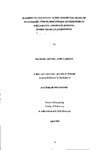Barriers to creativity in the conceptual phase of engineering design : perceptions of designers at Rolls Royce Aerospace (Bristol) in new projects engineering
| dc.contributor.author | Carkett, Rachel Amanda Jane | |
| dc.contributor.other | School of Engineering, Computing and Mathematics | en_US |
| dc.date.accessioned | 2013-11-07T13:32:00Z | |
| dc.date.available | 2013-11-07T13:32:00Z | |
| dc.date.issued | 2002 | |
| dc.identifier | NOT AVAILABLE | en_US |
| dc.identifier.uri | http://hdl.handle.net/10026.1/2661 | |
| dc.description | Merged with duplicate record 10026.1/693 on 03.04.2017 by CS (TIS) | |
| dc.description.abstract |
Anecdotal evidence from experienced engineers suggest that barriers to creativity are often due to the limitations of current technology, methods and support systems (Baird, Moore, & Jagodzinski, 2000). The aim of this research was to explore what the perceived barriers to creativity are and how they are circumvented by design engineers working in New Projects Engineering (NPE), Rolls-Royce Aerospace (Bristol). Semi-structured interviews with four employees working in engineering design comprised a Scoping Study. This provided a general overview of the major issues perceived by the design engineers regarding barriers to creativity and resulted in six themes being identified. These themes were used as a framework for a Design Group Interviews Study that followed. Sixteen engineers comprising project managers, team leaders, experienced designers and new designers, graduate employees and trainees were interviewed using the same method. Using grounded theory to analyse the data, sixteen categories were drawn from the data. Confirmation of the findings was achieved through presentations and workshops with different groups from Rolls-Royce, and the development of an Interrelationship Digraph illustrating the relationships between the categories. The second phase of the research focused on the phenomena under current working conditions. In the Tracking Study interview diaries recorded with thirteen design engineers over an eight week period highlighted the salient issues relating to their perceived barriers to creativity. Thirteen categories (some of which could be mapped onto the previous categories and some which were new) were drawn from the data. Validation of the categories was achieved through direct observations of two design engineers in the week long Shadowing Study and completed this phase of the research. Mapping and interpretation of the findings in relation to the literature obtained further verification. From these analyses it was becoming evident that perceived barriers to creativity were present at many different layers of the enterprise from a macro, organisational level to the micro-environment of the individual design engineer. The final phase entailed the development of a conditional/consequential matrix model to illustrate the relationship between the macro and micro conditions, under which barriers to creativity were investigated, leading to the development of a theory. The final conclusions and suggestions for improvements demonstrate the relationship between high/low barriers and high/low creativity. The research has shown the benefits of taking an interdisciplinary socio-technical approach and has highlighted the importance and relevance of the social dimension, as well as the technological, in the investigation of engineering design. | en_US |
| dc.description.sponsorship | Rolls-Royce plc | en_US |
| dc.language.iso | en | en_US |
| dc.publisher | University of Plymouth | en_US |
| dc.title | Barriers to creativity in the conceptual phase of engineering design : perceptions of designers at Rolls Royce Aerospace (Bristol) in new projects engineering | en_US |
| dc.type | Thesis | |
| plymouth.version | Full version | en_US |
| dc.identifier.doi | http://dx.doi.org/10.24382/4082 | |
| dc.identifier.doi | http://dx.doi.org/10.24382/4082 |
Files in this item
This item appears in the following Collection(s)
-
01 Research Theses Main Collection
Research Theses Main


